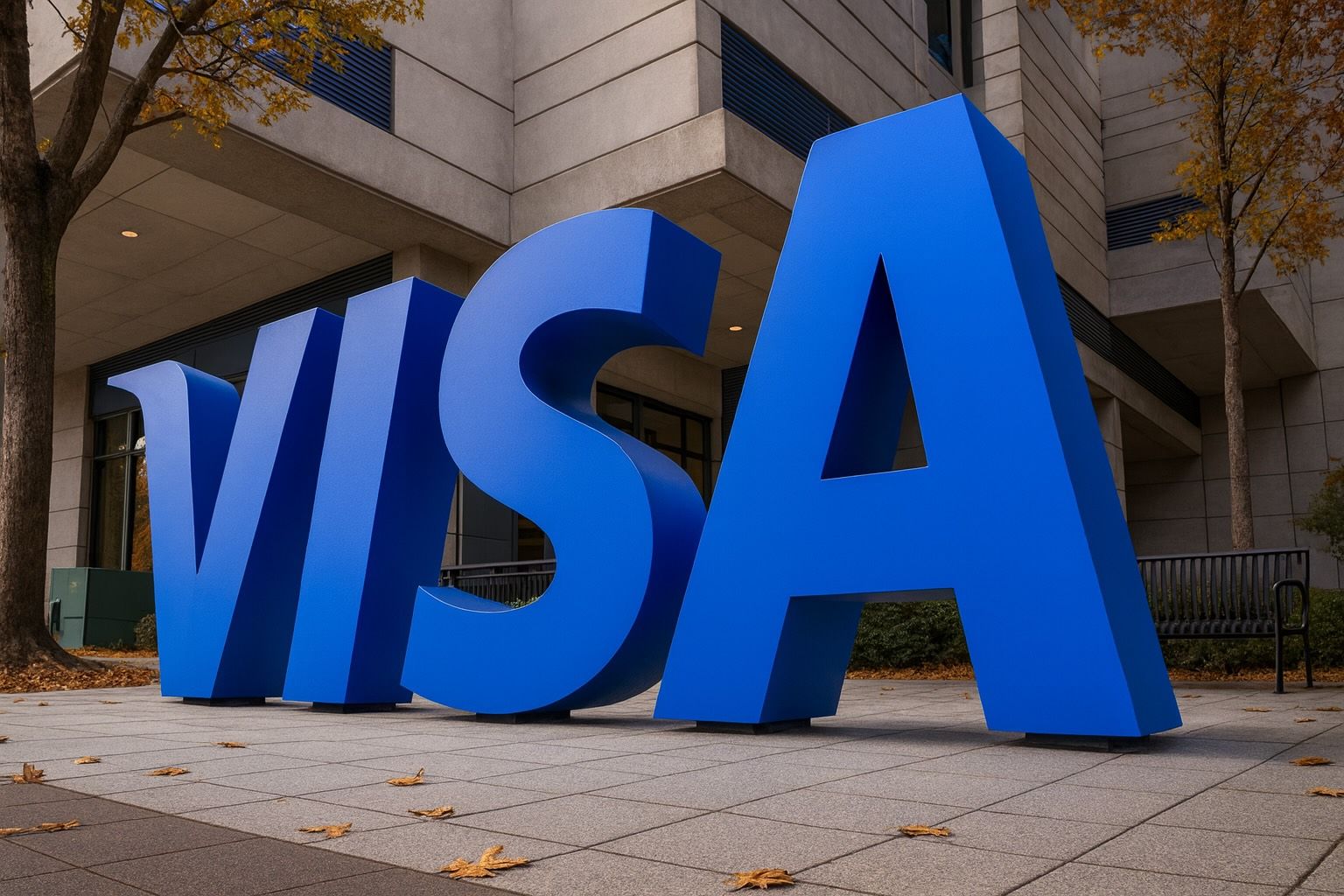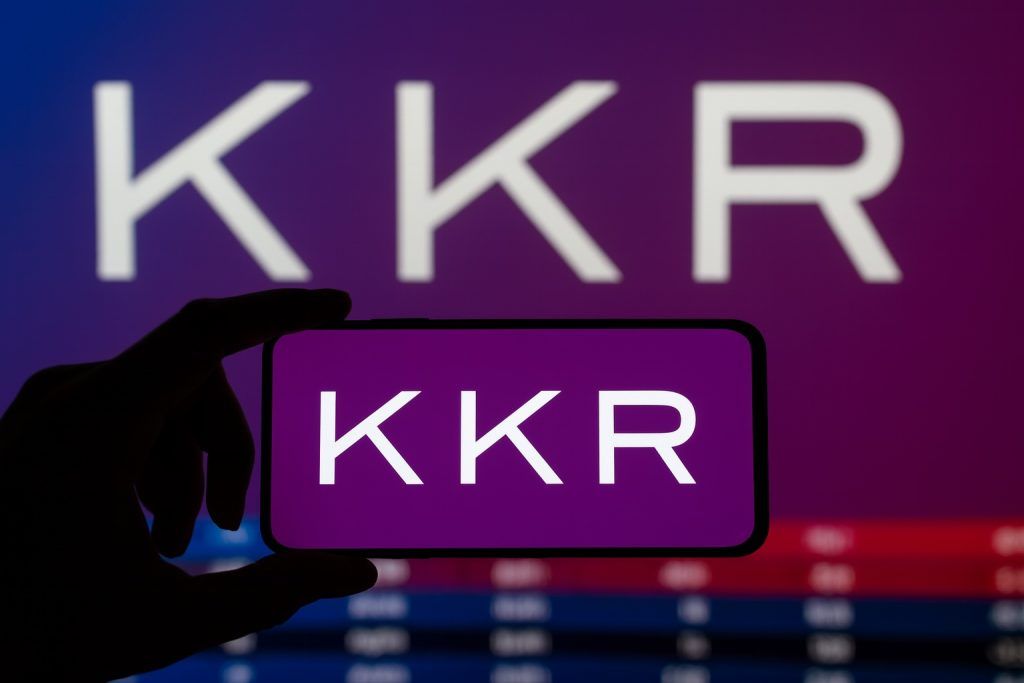- Sharp One-Day Drop: Visa Inc. (NYSE: V) shares closed at $335.40 on October 16, 2025, falling nearly 3% for the day [1]. The decline outpaced the broader market’s mild dip, pulling Visa’s stock to roughly flat-to-up single digits year-to-date (about +6–8% YTD) and ~21% higher than a year ago [2].
- Regulatory Clouds: Investor sentiment has been dented by regulatory headwinds. The U.S. Department of Justice (DOJ) is pursuing an antitrust lawsuit alleging Visa “suppressed competition” in the debit-card market [3]. Visa vehemently denies the claims as meritless and vows to “contest them vigorously”, according to its General Counsel Julie Rottenberg [4]. A federal judge recently refused to dismiss the case, so it will proceed – news that helped drive Visa’s stock to 2025 lows earlier this month [5]. In a separate case, Visa and Mastercard agreed to pay $199.5 million to settle a class-action lawsuit by small merchants who claimed the card networks unfairly shifted fraud liability costs to retailers [6].
- Fintech Initiatives: Despite legal overhangs, Visa is doubling down on innovation. In late September it launched a pilot enabling businesses to use U.S. dollar-backed stablecoins (crypto tokens pegged to the dollar) for cross-border payments instead of cash pre-funding [7]. This could speed up transactions and free up cash for companies. Visa’s Head of Commercial Money Movement, Mark Nelsen, noted the new U.S. stablecoin law provided the “regulatory clarity” needed to trial this blockchain-based system [8]. Separately, on Oct. 14 Visa introduced a “Trusted Agent Protocol” – an AI-driven security framework to help merchants verify legitimate AI shopping bots amid a surge in automated online shopping [9] [10]. Visa also struck new partnerships (e.g. a global deal with travel platform HotelRunner) to embed its payment network into more industries [11], aiming to drive additional transaction volume.
- Upcoming Earnings Catalyst: The company will report fiscal Q4 2025 earnings on October 28, 2025 [12], which could be a key stock catalyst. Visa’s last quarterly results (fiscal Q3) beat expectations – revenue jumped 14% year-on-year to $10.2 billion and adjusted EPS hit $2.98 [13] – as consumers kept spending robustly despite economic headwinds. CEO Ryan McInerney noted Visa saw “no meaningful impact” on spending from tariffs or inflation [14]. However, Visa maintained a cautious full-year revenue outlook (low single-digit growth), which some analysts interpreted as a conservative signal. RBC Capital Markets commented that the unchanged guidance was “the likely cause of negative pressure on the shares as it implies a deceleration in revenue growth” [15]. Investors will watch the upcoming report for any guidance updates and holiday spending trends.
- Analyst & Investor Outlook: Wall Street remains broadly bullish on Visa. Of 24 analysts covering the stock, the consensus rating is “Strong Buy” with an average 12-month price target around $389 – about 13–15% upside from current levels [16]. Many banks have issued lofty targets (several in the $400+ range); for example, Bank of America recently raised its Visa target to $410 [17]. Supporters cite Visa’s “large network effects and resilient spending trends” underpinning continued growth [18]. Long-term forecasts are upbeat as well: 24/7 Wall St. projects Visa’s stock will reach roughly $374 by end-2025 (≈10% above today) and climb past $400 in the next couple of years [19]. Institutional investors appear confident – over 82% of Visa’s stock is held by institutions, and major shareholders have been adding to positions [20]. (For instance, Aberdeen Group plc recently boosted its Visa stake by 7.8%, making it one of the fund’s top holdings [21].) Still, some analysts urge caution on valuation: at about 32–33× earnings (P/E) [22], Visa trades at a premium to the market and even above peer averages, which could limit upside unless growth stays strong. Notably, rival Mastercard trades around 37× earnings while fintech peer PayPal sits near 14× [23], highlighting the valuation gap.
Stock Slump Amid Market Jitters
Visa’s nearly 3% stock slide on Thursday caught investors’ attention. The drop, which sent shares to ~$335, was steeper than the broader market’s decline and came on the heels of already choppy trading in October. Market analysts attributed the slump partly to general risk-off sentiment – ongoing geopolitical tensions and concerns about banks had U.S. stocks dipping modestly on Oct. 16 [24]. However, Visa’s outsized fall suggests company-specific overhangs amplified the move. Traders noted that Visa and other payment stocks have been sensitive to news on regulation and rates, and Thursday’s decline erased roughly $10 from Visa’s share price, putting it near its lowest levels of the year.
Despite this pullback, Visa’s stock is still positive for 2025 to date, up high-single-digits percentage-wise. It also remains about 20% higher than it was at this time last year [25], thanks to a strong rally in late 2024 and steady gains through mid-2025. Visa’s 52-week range spans roughly $280 (lows last fall) to around $375 (highs earlier in 2025) [26] [27]. Even after the recent dip, shares are well above last year’s lows, reflecting how much Visa recovered as consumer spending rebounded. By comparison, the S&P 500 index is up by a similar mid-single-digit percentage year-to-date, so Visa has roughly tracked the broader market’s performance in 2025.
Market observers note that interest rate trends and economic signals are key for payment stocks right now. Hopes that the U.S. Federal Reserve might soon ease monetary policy have buoyed equity sentiment in recent weeks [28]. Payment giants like Visa tend to benefit from lower interest rates (which stimulate credit spending) and healthy consumer balance sheets. Currently, unemployment remains low and wages are growing, factors which have kept credit card volumes strong despite inflation [29]. That macro backdrop provided a tailwind for Visa through most of the year. But any signs of consumer weakness or higher credit losses at banks can spook the market and trickle into Visa’s stock. In short, Visa’s latest slide appears to be a mix of broader market jitters and lingering company-specific concerns, setting the stage for its upcoming earnings report to be especially pivotal.
Fintech Bets: Crypto and AI Payoffs?
Visa hasn’t let regulatory troubles stop it from forging ahead in financial technology innovation. Over the past month, the payments leader rolled out several initiatives aimed at keeping its network at the cutting edge of digital commerce:
- Stablecoin Pilot: In late September, Visa launched a pilot program allowing select corporate clients to settle cross-border transactions using stablecoins (cryptocurrencies pegged to fiat currency) rather than traditional bank wires. Under this pilot, businesses can hold USDC stablecoins (backed 1:1 by U.S. dollars) in Visa’s treasury and use them to send payments globally over blockchain networks [30]. The goal is to free up trapped cash (which would otherwise sit pre-funded in foreign accounts) and enable near-instant, 24/7 settlements. Visa’s Head of Commercial Money Movement, Mark Nelsen, explained that recent U.S. legislation (nicknamed the “Genius Act”) gave the “regulatory clarity” needed to attempt this crypto-based system [31]. Analysts say if widely adopted, such a system could eventually make international B2B payments faster and more efficient – a $40 trillion market that fintechs are eager to modernize [32]. While still experimental, Visa’s foray into stablecoins signals it doesn’t want to be left behind by the crypto and blockchain trend in payments.
- AI “Agent” Commerce: Just this week, Visa debuted its Trusted Agent Protocol, an industry framework to help merchants safely accommodate the rise of AI-driven shopping bots [33]. As more consumers delegate online shopping tasks to AI assistants (which can browse sites and place orders autonomously), merchants face a dilemma: blocking all bots could turn away legitimate AI shoppers, but allowing bots invites abuse by malicious actors. Visa’s new protocol provides a way for approved AI “agent” shoppers to prove their identity and intent to merchants via a kind of cryptographic handshake [34] [35]. This lets retailers verify a bot is trustworthy (e.g. an authorized personal shopping assistant) and not a fraudster’s script. The launch comes amid an explosion in AI-driven e-commerce – Visa cited Adobe data showing AI bot traffic to retail sites surged 4,700% over the past year [36]. By setting standards in this nascent “agentic commerce” space, Visa aims to position itself as a key infrastructure provider for secure AI-commerce transactions. Early feedback on the protocol involved players like Google, OpenAI, Stripe, Shopify, and others collaborating on interoperable standards [37]. This initiative underscores how Visa is expanding beyond traditional card payments, looking to secure its role in emerging digital payment flows (whether on blockchain or between AI agents).
- Partnerships and Network Expansion: Visa has also inked notable partnership deals to extend its reach. On October 10, it announced a global partnership with HotelRunner, a hospitality technology platform used by thousands of hotels and travel businesses [38]. Through this deal, Visa’s payment network will be embedded into HotelRunner’s systems, enabling more seamless cross-border payments in the travel industry (for example, a small hotel getting paid from an overseas tour operator via Visa rails). Visa’s Global Head of B2B Travel, Tania Platt, said the collaboration will help “travel businesses to connect, transact, and grow more seamlessly and securely” using Visa’s network [39]. Similarly, in the UK, Visa partnered with fintech Bluechain to let suppliers who don’t traditionally accept card payments get paid via Visa cards through Bluechain’s platform [40]. These tie-ups illustrate Visa’s strategy of plugging into new verticals and bringing more payment volume onto its network. With travel spending rebounding strongly in 2025 and B2B payments digitizing, Visa is positioning to capture those flows.
Analysts generally applaud these fintech bets and partnerships, seeing them as shoring up Visa’s long-term growth engine. “Visa is aggressively investing in new payment technologies,” noted TechStock², pointing to the stablecoin pilot and deals in travel and B2B as fueling optimism for future revenue streams [41] [42]. By innovating in areas like crypto and AI – while leveraging its scale in traditional card networks – Visa aims to sustain its dominance in an evolving payments landscape. However, these initiatives are also a nod to rising competition: fintech disruptors (from crypto startups to alternative payment platforms) continue to emerge, and Visa is clearly intent on adapting rather than getting disrupted. The payoff of projects like the stablecoin pilot or Trusted Agent Protocol will take time to gauge, but they signal that Visa is playing offense on technology. As one market commentator put it, “the network’s future will be shaped not just by courtrooms, but also by code” – meaning Visa’s legal battles and tech experiments are both pivotal to its trajectory.
Legal Headwinds: Antitrust and Fees Under Scrutiny
Overshadowing Visa’s tech-forward moves is a growing cloud of regulatory and legal challenges. The centerpiece issue is the DOJ’s antitrust lawsuit, which could potentially force changes to parts of Visa’s business if the government prevails. Here’s the latest on that and related developments:
- DOJ Antitrust Lawsuit: The U.S. Department of Justice, joined by several states, sued Visa in late 2024 alleging the company has unlawfully monopolized the debit card market. Specifically, the DOJ claims Visa used exclusivity contracts and fees to block rival debit networks (including newer fintech players) from gaining traction [43]. In essence, regulators argue Visa stifled competition to maintain its dominance and keep “swipe fees” (the fees merchants pay per transaction) high [44]. Visa strongly denies wrongdoing, insisting the debit market is “flourishing” with choice and that its rules are pro-competitive [45]. The legal battle took a turn this summer when a federal judge refused to dismiss the case, allowing it to proceed toward trial [46]. That outcome, announced in early October, unnerved investors – Visa’s stock slid on the news, hitting year-to-date lows as the market digested the prospect of a protracted court fight [47] [48]. The DOJ suit is still in early stages, but if it advances, potential remedies could range from fines to restrictions on Visa’s business practices. Some in Washington are even pushing broader legislation to curb credit/debit card fees, which could directly impact Visa’s revenue model [49]. For now, the uncertainty around this case is a overhang on Visa’s stock, though many analysts view it as a manageable risk rather than an existential threat. “These legal issues are a headwind to monitor rather than a death knell, since Visa’s core franchise remains highly profitable,” TechStock² observed [50].
- Merchant Class-Action Settlement: While the DOJ case looms, Visa and rival Mastercard moved to resolve another long-running legal dispute. This month, the two companies agreed to pay a combined $199.5 million to settle a class-action lawsuit brought by small merchants [51]. That case, originally filed in 2016, accused Visa, Mastercard and other networks of conspiring to shift fraud liability onto merchants unfairly during the U.S. rollout of EMV chip cards. Typically, if a chip-enabled card transaction was declined or deemed fraudulent, merchants alleged they were stuck with the losses even when the card networks’ systems were at fault. Visa and Mastercard denied the allegations but opted to settle “to avoid the further risk, expense and distraction” of protracted litigation, according to settlement documents [52]. Earlier, American Express and Discover had settled similar claims for $32 million [53]. The new $199.5M settlement (which is subject to court approval) will compensate the plaintiff merchants and put the issue to rest. For Visa, a roughly $100M share of that payout is trivial for a company earning over $15 billion annually, but the case’s resolution removes a legal irritation. More importantly, it underscores that Visa is under the microscope not just from regulators but from its own customers (merchants) over the costs and rules of its network. Merchant advocacy groups continue to lobby for lower interchange fees and greater choice in routing payments, issues central to both this settlement and the DOJ suit.
- Congressional & Other Regulatory Pressure: Beyond the courtroom, Visa faces political pressure regarding fees and competition. Lawmakers in the U.S. Congress have periodically introduced bills to curb credit card interchange fees – for instance, the proposed Credit Card Competition Act seeks to allow more competing networks for transactions, which Visa opposes. Meanwhile, the Federal Reserve’s FedNow instant payments system launched in 2023 has provided an alternative rail for certain payments (though not a direct competitor to Visa’s credit network, it reflects the push for faster, cheaper payments infrastructure). Internationally, regulators in regions like the EU have long capped card fees and could tighten rules further. Visa must navigate this environment where its high-profit margin business is a tempting target for regulation. The company’s line has been that its network provides enormous value by connecting millions of merchants and cardholders globally, and that over-regulating fees could stifle innovation and security. Still, the threat of regulation is unlikely to disappear. Investors are watching for any signs – such as court rulings, settlements, or new laws – that could materially affect Visa’s fee structure or competitive landscape. Each development, from antitrust motions to Senate hearings, can sway market sentiment on Visa in the near term. For example, when news broke about the DOJ case and a parallel class-action piggybacking on it (filed Oct. 8 in New York), Visa’s shares saw knee-jerk selloffs [54]. Conversely, any hints of a settlement with DOJ or cooling rhetoric on Capitol Hill could remove a layer of uncertainty and potentially boost the stock. In sum, legal/regulatory issues remain the wildcard for Visa’s otherwise steady business – a source of headline risk that investors are factoring into their outlook.
Wall Street’s Take: Bullish but Value-Conscious
Despite the noise around lawsuits and competition, the consensus in the financial community is that Visa’s fundamentals remain strong – and that the stock has room to run higher, albeit with some debate about how much. Here’s a look at what analysts and investors are saying:
Broad Optimism on Growth: A majority of analysts covering Visa have maintained buy-equivalent ratings in recent months [55]. The stock is widely seen as a core long-term holding in the payments/fintech space, given Visa’s global network dominance, high profit margins, and secular tailwinds (the ongoing shift from cash to digital payments). The average 12-month price target for Visa sits in the upper-$380s [56]. That would mark roughly 15% upside from the current ~$335 price – suggesting analysts see the recent pullback as an opportunity. In fact, several investment banks have raised their targets on Visa during the fall. For example, Barclays reiterated an Overweight rating and upped its target to $408 [57], and BofA Securities (Merrill Lynch) boosted its target to $410 in an Oct. 6 note [58]. A research note from UBS in September similarly called Visa a top pick, highlighting its resilient transaction volumes and pricing power. Overall, at least a dozen analysts have price goals north of $400, implying confidence that Visa can continue to deliver double-digit earnings growth in the coming year.
Rationale – Resilient Spending & Network Effects: The bullish case centers on the idea that consumer spending trends remain favorable and Visa’s competitive moat is intact. Even as economic growth has been mixed, consumers (especially in the U.S.) have kept up robust credit and debit card spending, including on travel, experiences, and everyday goods. “Mastercard benefits from strong discretionary demand – and by analogy so does Visa,” noted analysts at William Blair, pointing to how travel recovery and low unemployment are fueling card volumes [59]. Visa’s management has echoed this optimism; CEO Ryan McInerney recently said everyday spending is holding strong and that the company hasn’t seen significant pullback from inflation or tariffs [60]. Furthermore, Visa’s network effects – the massive two-sided network of millions of merchants and billions of cardholders – give it a durable advantage that new entrants struggle to match. This scale also allows Visa to invest heavily in security, innovation, and marketing, reinforcing its leadership. As long as electronic payments continue to grow globally (a trend in e-commerce, contactless payments, and digitization of emerging markets), Visa is positioned to capture a healthy share. Margins are another part of the story: Visa operates at profit margins above 50%, and initiatives like automation and AI (to fight fraud or improve onboarding) promise to sustain those margins even as the business expands. These factors underpin analysts’ projections of high-single-digit to low-double-digit revenue growth for Visa in the next few years, and even slightly faster EPS growth as buybacks shrink the share count [61].
Cautions – Valuation and Near-Term Uncertainty: Not everyone is unreservedly bullish. A minority of analysts and some value-focused investors point out that Visa’s stock isn’t cheap. At around 33 times trailing earnings and ~27× forward earnings [62], Visa trades at a premium to the market (the S&P 500’s forward P/E is roughly 18–20) and to many financial sector peers. Bulls argue Visa deserves a lofty valuation for its consistent growth and quality, but skeptics note the stock’s multiple is near the high end of its historical range [63]. “Visa faces slowing growth and rising regulation risks, all while trading at a premium valuation,” one Seeking Alpha contributor observed, rating the stock a Hold [64]. If interest rates stay elevated or consumer spending slows, there’s concern Visa’s growth could temporarily dip – which, combined with its rich valuation, might cap the stock’s near-term upside. Additionally, competitive threats bear watching. Fintech alternatives (like account-to-account payment apps, “buy now, pay later” services, or central bank digital currencies) could gradually chip away at some of Visa’s fee-based segments. For now, those threats are more long-term and diffuse, but the evolving landscape means Visa can’t be complacent. Even fellow giants like PayPal and Apple (with Apple Pay) are vying for a bigger role in payments, which could pressure transaction fees over time. Lastly, the DOJ lawsuit and regulatory overhang act as a wildcard – while most analysts aren’t panicking over it, they acknowledge it introduces uncertainty that might keep Visa’s stock range-bound until there’s more clarity. Rating agency Fitch, for instance, noted that extreme outcomes like forced divestitures are unlikely, but the process could result in legal costs or minor business adjustments that slightly weigh on future profitability.
Technical and Sentiment Signals: From a market technician’s perspective, Visa’s stock has been trading in a long-term upward channel on the charts [65], climbing steadily with occasional pullbacks. The recent dip puts shares below their 50-day moving average, a sign of short-term weakness, but still above longer-term support levels (like the 200-day average). Many chart analysts see strong support in the low-$300s (where Visa bottomed last fall), and resistance around $360–$370 (recent highs). In other words, the stock appears to be consolidating in a range as investors await a new catalyst. That catalyst could be the upcoming earnings or a resolution (or escalation) of the legal issues. Options trading in Visa has also picked up, indicating some traders positioning for volatility around the earnings date. On the sentiment front, institutional ownership remains high at over 82% [66] – a sign that big money investors (funds, pensions, etc.) remain confident in Visa’s story. Notably, several large institutions added to their Visa positions in recent quarters [67] [68]. Vanguard, for example, now owns over 160 million Visa shares, and others like Northern Trust and Wellington Management also increased their stakes this year [69] [70]. Such accumulation suggests smart money support for Visa, even as headline risks make waves.
Forecasts – Near and Far: Looking ahead, market watchers generally expect Visa to continue its steady growth trajectory. For the upcoming FY2025 results (to be reported Oct. 28), consensus estimates anticipate low double-digit percentage growth in revenue and earnings [71], reflecting resilient payment volumes. If Visa meets or beats those numbers and perhaps raises its outlook, the stock could break out of its range to the upside. On a longer horizon, some forecasts see Visa hitting new highs: as noted, 24/7 Wall St. predicts ~$374 by end of 2025 and projects the stock will cross $400 in 2026 or 2027 [72]. By 2030, given the compounding of high single-digit growth, Visa’s stock could potentially be considerably higher (some extrapolations put it in the $500+ range by decade’s end if trends hold). Of course, such long-term predictions are speculative. Much will depend on how well Visa adapts to the changing payments ecosystem – including capturing opportunities in emerging markets (where cash is still prevalent), embracing new technologies like crypto/AI (as it’s starting to), and navigating regulatory changes.
For now, Wall Street’s base case is that Visa remains a juggernaut: a company with reliable growth, expanding dividends (it currently yields about 0.7% with regular payout hikes [73]), and ample free cash flow for ongoing stock buybacks. That profile makes it attractive even in uncertain times. “Visa’s 10-year returns (~420%) have far outpaced the S&P 500” over the last decade [74], one analysis noted, underscoring the wealth it has created for shareholders. The consensus view is that a similar, if perhaps slightly moderated, path can continue. As one analyst quipped, “People aren’t going to stop swiping their Visas” – and with each swipe (or tap or click), Visa Inc. takes a tiny toll that adds up to billions in profit. Barring any shock from regulators or technology that changes that toll model, the odds seem in favor of Visa’s stock resuming an upward climb after this period of uncertainty passes.
Industry Context: Fintech Trends and Competitive Landscape
Zooming out, Visa’s story is also a lens on the broader fintech and payments industry in 2025. The sector sits at an interesting crossroads of high growth potential, intense innovation, and increasing oversight:
- Digital Payments Boom: The secular shift from cash to digital payments is a multi-decade trend that still has legs. Even in developed markets, more transactions are moving to cards, mobile wallets, and online systems. In emerging markets, the runway is longer as millions of people join the financial system. Visa (along with Mastercard) is a prime beneficiary of this macro trend – every percent of global payments that converts to electronic is new business for them. The pandemic years accelerated some of this behavior (contactless payments, e-commerce), and those habits have largely stuck. Fintech firms, from payment processors to neobanks, are also riding this wave. Visa has been partnering with many fintechs (e.g. powering their debit cards or integrating with their apps) to avoid disintermediation. The rise of real-time payment networks and peer-to-peer apps is one area to watch; while they don’t immediately dethrone card networks for most commerce, they indicate new preferences for speed and convenience that Visa is working to match (e.g. via Visa Direct and other initiatives [75]). Overall, the pie of electronic payments is growing, which provides a tailwind for incumbents and newcomers alike.
- Competition and Collaboration: Visa’s main traditional competitor is Mastercard, which operates a very similar business model globally. The two tend to face parallel industry forces – indeed, Mastercard is also dealing with comparable antitrust scrutiny and is investing in crypto/AI capabilities. Both enjoy a duopoly in many markets for credit/debit network services (with American Express and Discover as smaller rivals in the U.S.). This has historically meant strong pricing power (hence the high margins and fees that attract regulators’ ire). Going forward, Visa and Mastercard are increasingly positioning themselves as broad “payment technology” companies rather than just card processors. They’ve each acquired fintech firms in areas like open banking, fraud prevention, and cross-border transfers to diversify services. They also often collaborate with putative competitors; for example, Visa supports multiple digital wallet platforms (Apple Pay, Google Pay, PayPal, etc.), recognizing that as long as those wallets ultimately use Visa’s rails, it’s a net positive. Still, tech giants and fintech upstarts pose a long-term challenge. Companies like Block (Square) and Stripe provide payment solutions to merchants that partly bypass traditional networks (though most still rely on cards somewhere in the chain). Cryptocurrencies and decentralized finance present alternative visions of value transfer without central intermediaries, though their mainstream impact has been limited so far (and Visa’s own crypto moves indicate it wants a foot in that door). The competitive takeaway: Visa’s moat is broad but not invulnerable – it will need to keep innovating and possibly adjusting pricing to stay on top in an evolving landscape of payment options.
- Regulatory Environment: The payments industry is undeniably under greater regulatory scrutiny worldwide. Interchange fees (the fees merchants pay per transaction) are a focal point; high fees have led to discontent among retailers and scrutiny by regulators. In the EU and other regions, interchange is capped at low levels for consumer cards, pressuring network revenues (though Visa and Mastercard have compensated by increasing volume and diversifying fees). In the U.S., where interchange is higher, the political climate has seen populist appeals to rein in “excessive” card fees that burden small businesses. Additionally, data privacy and security regulations affect how payment companies operate, especially with the rise of open banking (which requires banks to share data with fintechs via APIs – an area Visa entered by acquiring Plaid, although that deal was scuttled by the DOJ in 2020). Now with AI coming into finance, regulators may impose new rules on algorithmic decisions in credit and fraud detection. Visa’s proactive approach with initiatives like Trusted Agent Protocol could help shape best practices and perhaps forestall heavy-handed regulation by showing the industry can self-regulate. Nonetheless, investors accept that compliance costs and legal risks are part of doing business for a company of Visa’s scale. So far, Visa has managed these issues adeptly – often lobbying and negotiating to favorable outcomes (for instance, settling disputes or adjusting practices to satisfy regulators without major damage to its model). The outcome of the current DOJ suit and any new legislation will be telling for how the industry balances innovation, competition, and regulation in the years ahead.
- Consumer Behavior and Economic Factors: Ultimately, Visa’s fortunes (and those of its industry peers) rise and fall with consumer and business spending. Trends like the resurgence of travel spending (post-pandemic) and a shift toward experiential purchases have benefited card networks, as people swipe their cards for airline tickets, hotel stays, concerts, and dining out – categories that often carry higher transaction values (and fees) than everyday staples. On the flip side, inflation has a mixed impact: it can increase transaction sizes (higher prices mean larger charges on cards, boosting network revenues), but if it outpaces wage growth, it can curb consumer purchasing power. So far in 2025, U.S. inflation has moderated and wage growth has been healthy, meaning consumers are largely keeping up – translating into steady payment volumes [76]. A strong labor market (low unemployment) has supported credit health as well; card delinquencies have ticked up from ultra-low levels but remain manageable, and banks are still issuing new cards and loans. Should the economy tip into recession or unemployment rise sharply, consumer spending could retrench, which would directly hit Visa’s volumes. This is a known cyclical risk – Visa isn’t recession-proof, though its business tends to be more resilient than many because even in downturns, a lot of spending (groceries, utilities, etc.) still happens on cards. Moreover, Visa doesn’t take credit risk (banks do), so credit losses don’t hit Visa’s P&L, but a widespread pullback in spending would slow its revenue growth. For now, forecasts for 2026 and beyond generally assume moderate global economic growth, continued secular shift to digital payments, and thus high-single-digit growth for Visa. That could change if macro conditions shift, so it’s something both company management and investors keep a close eye on.
Conclusion
Visa Inc. finds itself at a pivotal moment as of late 2025. On one hand, the company is firing on all cylinders operationally – spending on its network is climbing, new technologies like stablecoins and AI are being embraced, and most analysts remain convinced of Visa’s long-term growth story. On the other hand, the stock’s recent stumbles reflect real challenges: regulators questioning its market power, investors debating its lofty valuation, and a market awaiting more clarity on earnings momentum. The next few weeks could be telling. Visa’s upcoming earnings report and any further news on the DOJ suit or fee legislation will likely shape the stock’s direction into year-end.
For investors and observers, Visa is a bellwether for both the health of the consumer and the evolution of fintech. Its sheer size and ubiquity mean that if you want to gauge how confident people are in the economy, or what new payment method might gain traction, Visa’s results and actions provide valuable clues. As of now, the narrative seems cautiously positive: consumer spending is holding up, Visa is adapting to new tech and defending its turf, and the company continues to churn out strong profits. The roughly 15% upside that analysts see in the stock suggests there is optimism that the current clouds will eventually part.
Of course, no journey is without bumps. Visa’s management faces the task of executing on growth initiatives (like those fintech pilots) while deftly handling legal disputes. They must reassure both the public sector and the public markets that Visa can innovate and compete fairly without harming the ecosystem that so many businesses and consumers rely on daily. If they succeed, Visa’s stock could very well regain its upward momentum and reward patient shareholders. If not, volatility may linger.
For now, the takeaway for readers and investors is: Visa remains a cornerstone of the payments world, with unmatched scale and reach. Its stock is experiencing a bit of turbulence amid a mix of external noise and high expectations. But many experts believe the company’s fundamentals and strategic direction will win out. As one analyst put it, “Visa has navigated every challenge thrown at it over the last decade – from economic crises to digital disruptions – and emerged stronger [77].” Time will tell if 2025’s hurdles will be the same, but the bet on Wall Street is that Visa will keep swiping onward and upward.
Sources: Financial news and data as of Oct. 16, 2025, including TechStock² (ts2.tech) [78] [79], Reuters [80] [81], Payments Dive [82], MarketBeat [83] [84], and Visa’s investor disclosures [85].
References
1. companiesmarketcap.com, 2. companiesmarketcap.com, 3. ts2.tech, 4. ts2.tech, 5. ts2.tech, 6. www.paymentsdive.com, 7. ts2.tech, 8. ts2.tech, 9. venturebeat.com, 10. venturebeat.com, 11. ts2.tech, 12. ts2.tech, 13. ts2.tech, 14. ts2.tech, 15. www.reuters.com, 16. ts2.tech, 17. ts2.tech, 18. ts2.tech, 19. ts2.tech, 20. www.marketbeat.com, 21. www.marketbeat.com, 22. companiesmarketcap.com, 23. companiesmarketcap.com, 24. ts2.tech, 25. companiesmarketcap.com, 26. ts2.tech, 27. ts2.tech, 28. ts2.tech, 29. ts2.tech, 30. ts2.tech, 31. ts2.tech, 32. finance.yahoo.com, 33. venturebeat.com, 34. venturebeat.com, 35. venturebeat.com, 36. venturebeat.com, 37. venturebeat.com, 38. ts2.tech, 39. ts2.tech, 40. ts2.tech, 41. ts2.tech, 42. ts2.tech, 43. ts2.tech, 44. ts2.tech, 45. ts2.tech, 46. ts2.tech, 47. ts2.tech, 48. ts2.tech, 49. ts2.tech, 50. ts2.tech, 51. www.paymentsdive.com, 52. www.paymentsdive.com, 53. www.paymentsdive.com, 54. ts2.tech, 55. ts2.tech, 56. ts2.tech, 57. www.marketbeat.com, 58. ts2.tech, 59. ts2.tech, 60. ts2.tech, 61. www.marketbeat.com, 62. companiesmarketcap.com, 63. companiesmarketcap.com, 64. seekingalpha.com, 65. ts2.tech, 66. www.marketbeat.com, 67. www.marketbeat.com, 68. www.marketbeat.com, 69. www.marketbeat.com, 70. www.marketbeat.com, 71. www.nasdaq.com, 72. ts2.tech, 73. www.marketbeat.com, 74. ts2.tech, 75. usa.visa.com, 76. ts2.tech, 77. ts2.tech, 78. ts2.tech, 79. ts2.tech, 80. www.reuters.com, 81. ts2.tech, 82. www.paymentsdive.com, 83. www.marketbeat.com, 84. www.marketbeat.com, 85. investor.visa.com







